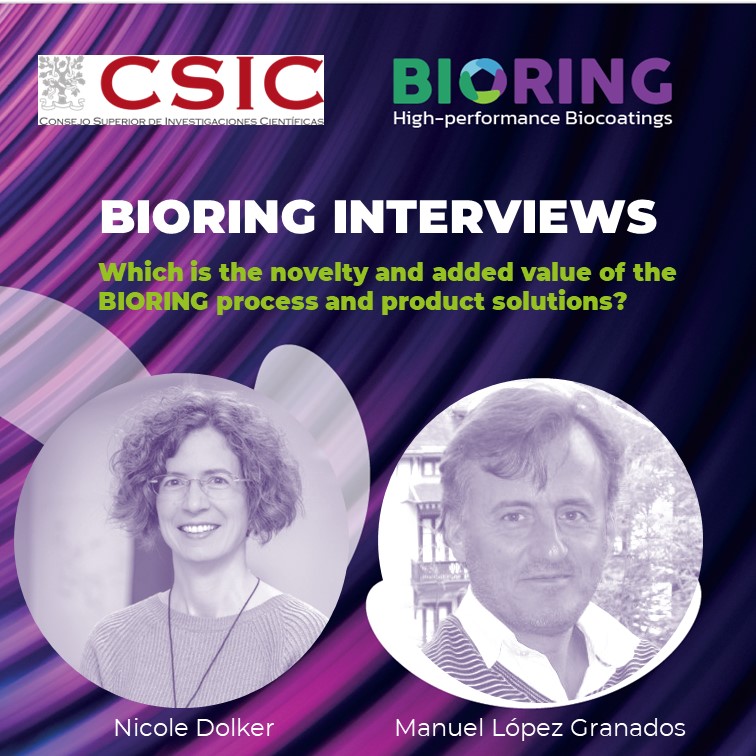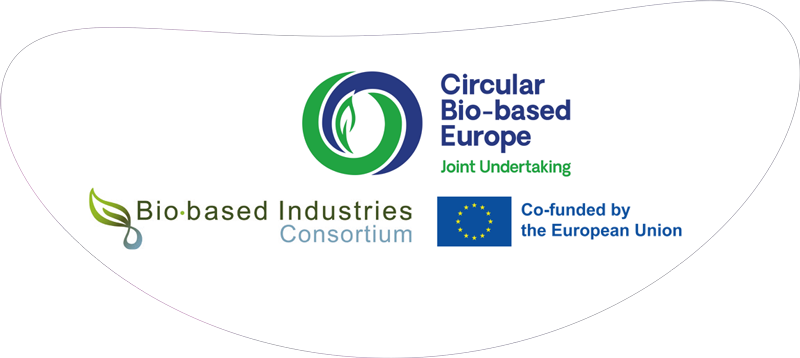The devil is in the details: our experience on the synthesis of alternative, sustainable, biobased chemicals
Interview to Manuel López Granados and Nicole Doelker, Institute of Catalysis and Petrochemistry of the Spanish National Research Council (CSIC) and BIORING Coordinators
(Interview made on 19th April 2024)
Which is the novelty and added value of the BIORING process and product solutions?
If we look at sectors such as automotive and furniture, the ones in which BIORING works, developing and using polymers with a relatively low biobased content, let’s say around 20-30%, is well known and feasible. There are already some examples on the market, or close to it. However, moving to materials with a large majority of biobased contents, and similar performances and costs as conventional materials, is a difficult challenge.
BIORING aims to do a step-forward in the synthesis of alternative, sustainable, and biobased chemicals addressing three main challenges: first, to synthetise the building blocks, converting biomass into polymers. We will develop molecules, which can be derived from biomass and contain specific functionalities that allow to polymerize them. We need to solve significant chemical problems, including selection of catalysts and separation and purification of products, among many others. Second, to adapt the current polymer chemistry processes to the new building blocks. Polymerization does not happen in the same conditions as in conventional approaches, and might be more complex, slow, and costly. We are taking a chemical process developed in decades of work and try to stretch and adapt it to the new biobased molecules. Third, to do it in a cost-effective way. Despite the novelty and complexity of the new chemistry, we need to avoid making significant changes to conventional processes. The fewer are the changes in the production process will require, the higher will be the potential for market uptake of BIORING solutions.
Which are the most relevant barriers to overcome?
Besides the scientifical challenges in the chemicals and polymer formulation, we think a main barrier is the upscale and deployment in production, replacing conventional chemicals with alternatives.
New technologies can be easily integrated if they do not require major changes in existing process and protocols. Ideally, they are “drop-in”, you just need to replace a chemical with a new one.
In BIORING we will not develop a process identical to existing fossil-based counterpart, but rather something similar and adaptable. We are developing a flexible platform, with which you will be able to use the BIORING solution, as well as building-blocks developed by others. That will make it faster and cheaper for companies to adopt our process. We aim to provide the closest possible to a drop-in solution.
What are the pros and cons of using biobased feedstock, and how is BIORING doing it?
There are well-known barriers related to the use of biobased feedstocks.
A major issue could be the change of the material over time, bringing problems in terms of supply and reproducibility. We need to be sure about the quality of our biomass: which type it is, where it comes from, its availability (e.g. seasonality) in which conditions you keep it, how it grew, its composition and purity, etc. For example, wood residues might be easy to control, but other feedstocks vary a lot.
During the project, this should not be a big problem, given the scale of our production; but in a longer term and at a larger scale, obtaining enough material with appropriate quality could become complex.
Another important barrier for biobased feedstocks might be the cost compared to conventional chemicals. In the case of coatings, which are applied as very thin layers, the quantity of material used to produce the final products is limited, so that the cost of the coating materials is less relevant. This could be an advantage in the exploitation of BIORING solutions. Moreover, In BIORING, given the type of process envisaged, we expect that the feedstock will likely not impact much on the costs of the overall product. However, we expect extra costs might arise from the novel and more complex catalytic process we are developing.
The project foresees specific tasks to monitor and optimize quality, reliability, and costs of the processes and products developed.
Eventually, another issue are the real environmental benefits along the life cycle: though the feedstock itself is more sustainable, the new chemistry, processes, conditions of use might change the overall footprint of the product along its life cycle.
In our case, coatings remain a thin layer of an overall component (furniture/car parts), so it will likely impact little in the overall footprint of the product. But it is a very important issue which needs to be well understood. Optimizing the overall footprint is a problem for any new product, including biobased ones, as pitfalls are in unexpected places. For example, you could make a recyclable product, but which requires huge amounts of water or energy to be recycled. The devil is in the technical details!
In BIORING, it’s early to indicate what will be the critical points: we will use solvents, and although we are trying to use non-toxic options, this aspect may become critical and must be monitored closely during the project. That’s why we have partners and specific tasks devoted to checking and understanding all aspects of safety and sustainability.
What do you like the most and what are your expectations in participating to the BIORING project?
Being able to successfully synthesise high value monomers in a sustainable way. Being capable of purifying them. Obtaining cheap monomers of high quality!
Taking a step forward in biomass processing, and the transformation of biomasses in platform chemicals, connecting with polymer chemistry, cooperating with partners, and applying to the best our common knowledge.
It is a truly cooperative project, we need to share, combine, and integrate the competences, expertise, networks of all partners to achieve our goals, it would be impossible to do it alone.
How you plan to follow up and uptake the experience and results of BIORING in the future?
We are having a lively discussion in our organization on these aspects: the logical step after a research and innovation action like BIORING is to develop a pilot plan to increase volumes and reach higher TRLs (e.g., in the context of an Innovation Action). However, this is not a natural step for a research organization. Building and maintaining a pilot plan for each of the many research results we develop in our lab would require too much effort.
We also realized that there are limited funding instruments available to help organizations like us to follow up on results of a Research and Innovation Action. And if we look at industry, they might not be interested to invest in a process at TRL5, as it is still too risky.
In the specific case of BIORING, the project includes some industry partners that are used to working in developing and scaling up prototypes, who could deploy BIORING solutions. But for sure we will also have to also look for further funding opportunities and partnerships to complement their expertise and exploit the different project results.
About
Dr. Manuel López Granados, Project Coordinator, centres his research interest on the development of catalytic technologies for the valorisation of biomass to valuable renewable chemicals, monomers and biofuels. In BIORING, he aims at developing novel methods for the catalytic production of various of the biobased building blocks that form the basis for the subsequent polymerisation and production of bio-coatings.
Dr. Nicole Doelker, Project Manager, is a chemist by training with over 10 years of experience in Consulting and Project Management. She is in charge of the overall coordination of the BIORING activities.


